 Back to the Be Inspired Blog
Back to the Be Inspired Blog

How to Add Japanese Maples to Your Landscape Design
Japanese maple trees are known for their spectacular colors and elegant shapes, adding vibrancy and balance to the landscape. Adding them to your garden can turn your home and yard into a complete showstopper. Read on for tips for landscaping using Japanese maple trees.
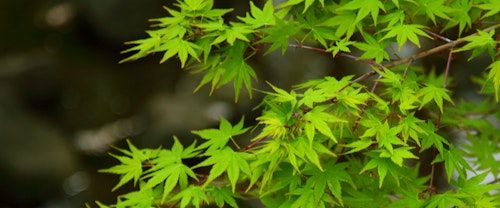
What are Japanese Maples?
These glorious trees come in hundreds of varieties with varying hues of foliage in bold red, fiery orange, lush green, deep purple, and more. Depending on the variety, they can grow between 8 and 30 feet in height. They grow quite quickly when they are young and slow down as they reach full maturity. On average, you can expect 1-2 feet of growth per year.
Planting Japanese Maples
When landscaping with Japanese maples, consider your space, soil, and amount of sunlight. An area with partial shade and protection from harsh winds would be your best bet when planting Japanese maples. You can plant Japanese maples in fall or spring, as long as there's no threat of frost immediately coming to harm your delicate new tree. Plant your Japanese maple in well-draining and acidic soil with mulch. If your soil's pH levels are too high, your Japanese maple leaves may turn yellow. These trees like to stay moist but not soaked, and your best bet is to plant them on a slight elevation to keep their root systems healthy and free of rot and disease. One fantastic feature of the Japanese maple is that they are capable of "self-stunted growth," which means that if they are planted in a restricted container, they know not to outgrow their container. If you’re planning to grow your Japanese Maple in a container, we recommend choosing a dwarf variety.
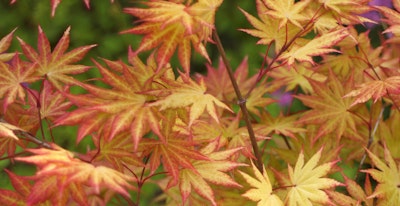
How to Care for Japanese Maples
Fertilize your new Japanese maple when it's freshly planted and then for at least two years after that. Fertilize with a low-nitrogen fertilizer in the very early spring, but avoid adding any after May. It may change the tree's natural process, and you'll miss its most beautiful fall coloring.
Water thoroughly when you first plant your Japanese maple and keep it well-watered as much as possible. They can handle some dry spells but don't deal well with extremes. Adding mulch to your tree can help regulate its water distribution and keep it healthy and protected.
If you want your Japanese maple to have a certain aesthetic, you can prune it into a canopy by removing lower branches or thin out branches if you want it to look a bit airier. One thing to remember when pruning these trees is that it oozes sap most months of the year, and losing that sap will make your tree weak and susceptible to disease. Aim to prune in July and August. If you notice any shoots growing out of the base of your tree, these need to be pruned, as they will leech off the tree and eventually weaken your tree and overtake it.
Keep pests and diseases under control by regularly checking your Japanese maple for mites, scale, aphids, root weevils, stem canker, fusarium, botrytis, and verticillium wilt. Know the signs, but don't worry too much: Japanese maples are pretty tenacious!
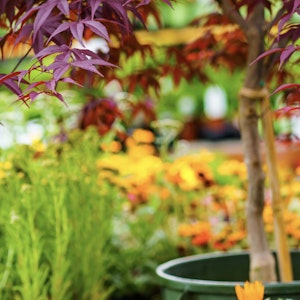
What to Plant Near Japanese Maples
Japanese maples can be stunning focal points on your property. When considering landscaping design, keep in mind that these trees can get along with various other flowers, shrubs, and trees.
Flowers: Add plenty of colorful ground cover around the base of your Japanese maple with bold perennials. You can choose colors that complement the variety of foliage your tree produces. One great option is the azalea, which comes in tons of varieties to choose from to suit your style.
Conifers: Planting a collection of conifers can really highlight the beauty of the Japanese maple. Think of them as the backup dancers of the tree world. They compliment the beauty of the leading tree.
Sedum: Sedum is a great option for ample ground cover. It's a low-maintenance succulent that doesn't need much except sunlight and well-draining soil. Its yellow and green foliage can complement any Japanese maple without stealing the spotlight.
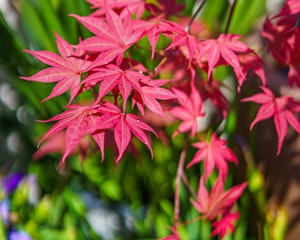
Japanese Maple Varieties
While there are hundreds of Japanese Maples to choose from when considering your landscaping, here are a few of our favorites.
Crimson Queen:
The glorious Crimson Queen is a dwarf variety of Japanese maple. With stunning crimson coloring and a "weeping" shape, this would be a great variety for container planting.
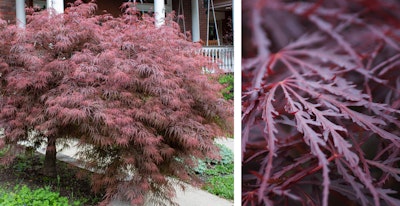
Aconitifolium:
Also known as Maiku Jaku, it is one of the most stunningly beautiful varieties with amazing leaves that transform from green to yellow, orange, and red.
Golden Full Moon Maple:
This variety of Japanese maple embodies the spirit of fall for several months of the year. It has perfect autumn shades of yellow, red, and orange.
Green Cascade:
Another weeping variety, it has delicate green leaves that can turn a vibrant scarlet during the fall months. You can stake this tree up or let it flow romantically wherever it pleases.
We know you'll love Japanese maples as much as we do! If you're looking for more tips on landscaping with Japanese maple trees in California, contact us. We'd love to help you design your perfect landscape and garden this year.

